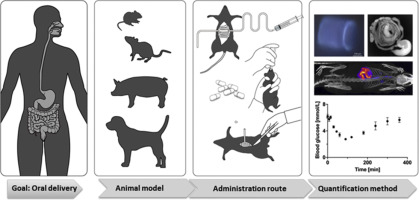Journal of Controlled Release ( IF 10.8 ) Pub Date : 2017-09-19 , DOI: 10.1016/j.jconrel.2017.09.025 Stine Harloff-Helleberg , Line Hagner Nielsen , Hanne Mørck Nielsen

|
Biopharmaceuticals are increasingly important for patients and the pharmaceutical industry due to their ability to treat and, in some cases, even cure chronic and potentially life-threatening diseases. Most biopharmaceuticals are administered by injection, but intensive focus on development of systems for oral delivery of biopharmaceuticals may result in new treatment modalities to increase the patient compliance and reduce product cost.
In the preclinical development phase, use of experimental animal models is essential for evaluation of new formulation designs. In general, the limited oral bioavailability of biopharmaceuticals, of just a few percent, is expected, and therefore, the animal models and the experimental settings must be chosen with utmost care. More knowledge and focus on this topic is highly needed, despite experience from the numerous studies evaluating animal models for oral drug delivery of small molecule drugs. This review highlights and discusses pros and cons of the most currently used animal models and settings. Additionally, it also looks into the influence of anesthetics and sampling methods for evaluation of drug delivery systems for oral delivery of biopharmaceuticals primarily with examples on insulin.
中文翻译:

评估口服生物药物的动物模型
由于生物药物具有治疗甚至在某些情况下甚至治愈慢性和可能危及生命的疾病的能力,因此对于患者和制药行业而言,其重要性日益提高。大多数生物药物是通过注射给药的,但是对生物药物口服给药系统开发的高度关注可能会导致新的治疗方式,以增加患者的依从性并降低产品成本。
在临床前开发阶段,使用实验动物模型对于评估新配方设计至关重要。通常,预期生物药物的口服生物利用度有限,仅为百分之几,因此,必须格外小心地选择动物模型和实验环境。尽管有许多评估小分子药物口服药物递送动物模型的研究经验,但仍需要更多的知识和对这一主题的关注。这篇评论重点介绍并讨论了当前最常用的动物模型和环境的利弊。另外,它还考察了麻醉剂和采样方法对评估用于口服递送生物药物的药物递送系统的影响,主要是关于胰岛素的例子。



























 京公网安备 11010802027423号
京公网安备 11010802027423号